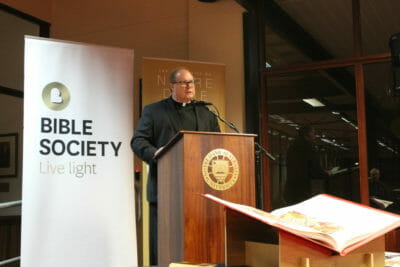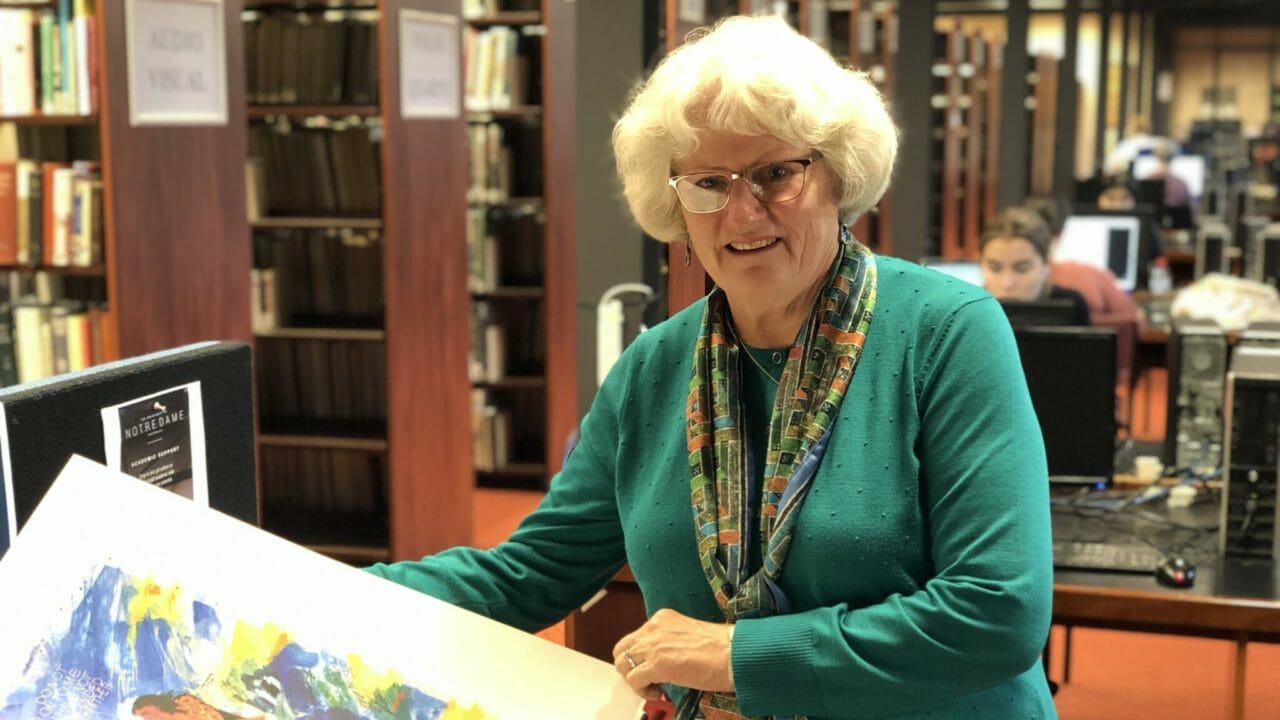The utility of the The Saint John’s Bible is to become part of an organization’s mission – whether that mission is healing, education, spiritual introspection, cultural enrichment or artistic appreciation. Dr. Angela McCarthy, Senior Lecturer of Theology at the University of Notre Dame Australia, said that it’s become more than that for the university. “We must engage in beauty that draws us to God,” she said, adding that support for religious art like The Saint John’s Bible is “part of the mission for authentic Catholicity.”
And for a university that adheres to the Catholic intellectual tradition, which encourages critical and creative thought alongside a theological base, authenticity is constantly balanced with new ways of seeing and experiencing the Word. McCarthy said, “The Catholic intellectual tradition can become very stale if it remains intellectual, so [The Saint John’s Bible] can help change that.”
Changing the Focus of Study
 The Heritage Edition has already “opened up many conversations” with other groups, McCarthy said, since its debut at the university in late May. The University’s first Festival of Religious Art kicked off their Year with The Saint John’s Bible, featuring works by recipients of the Mandorla Art Award for the best religious art in Australia created from a set Biblical theme; exhibition of several rare Bibles from the Bible Society of Australia (a sponsor of UND’s Year with The Saint John’s Bible); and lectures and presentations from art scholars, Biblical scholars, and one of Australia’s foremost iconographers.
The Heritage Edition has already “opened up many conversations” with other groups, McCarthy said, since its debut at the university in late May. The University’s first Festival of Religious Art kicked off their Year with The Saint John’s Bible, featuring works by recipients of the Mandorla Art Award for the best religious art in Australia created from a set Biblical theme; exhibition of several rare Bibles from the Bible Society of Australia (a sponsor of UND’s Year with The Saint John’s Bible); and lectures and presentations from art scholars, Biblical scholars, and one of Australia’s foremost iconographers.
“The impetus of The Saint John’s Bible will have a long-term effect on our culture,” McCarthy said. “The Festival of Religious Art was designed to augment the launch of our Year with The Saint John’s Bible. It was used in an Academy of Liturgy meeting and completely changed the focus of what we were doing.” She also shared examples of student groups, from preteens to high schoolers, who stunned their instructors with “silence and stillness” during viewings. “They were deeply moved by the beauty. It gives us a global perspective in terms of the value of beauty in everyone’s lives.”
Reaching All Levels of the University
McCarthy and UND Australia continue to share the Heritage Edition with the community by reaching out to local religious denominations and educational institutions for viewings (which she said is “critical to developing ecumenical relationships”), touring it at conferences and groups, and displaying it at public galleries. In between these, the Bible stays in the library and is the subject of  a twice-weekly information session culminating in page-turning immediately before Mass – so needless to say, UND Australia’s Heritage Edition is already seeing plenty of mileage. McCarthy will even be using the Heritage Edition as a “primary experience” for every class in a liturgy program, using the Bible and associated writing to explore “the value that such beauty provides in the learning experience”.
a twice-weekly information session culminating in page-turning immediately before Mass – so needless to say, UND Australia’s Heritage Edition is already seeing plenty of mileage. McCarthy will even be using the Heritage Edition as a “primary experience” for every class in a liturgy program, using the Bible and associated writing to explore “the value that such beauty provides in the learning experience”.
But McCarthy said the larger benefit of hosting The Saint John’s Bible is its ability to create experiences that reach key decision-makers. “The response from all levels of governance, particularly the Chancellor and Governors of the University, has been explicit: this is a … very important aspect of our cultural life that the University should be engaged with in the future,” she said.
“There are so many facets of The Saint John’s Bible that reach people – the history, the calligraphy, the project itself, the cost and funding of the project – but mostly the beauty … It can draw all levels of the University into contemplation of the Word in a completely different way.”

